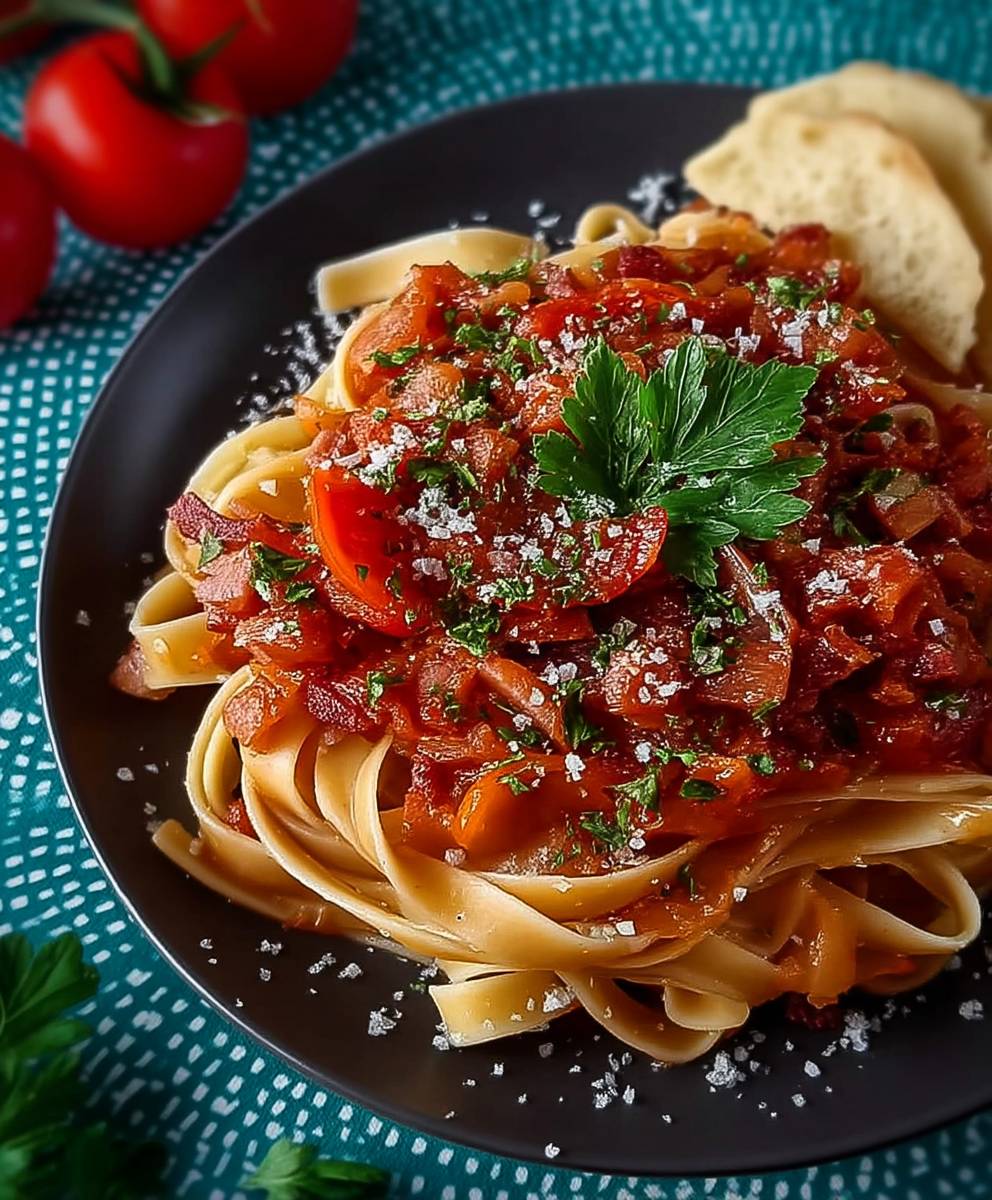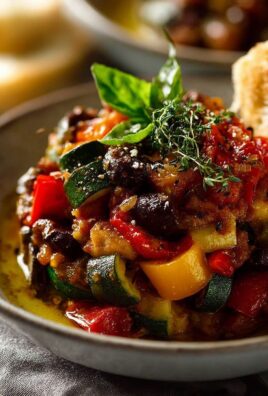Pasta Amatriciana: just the name conjures up images of sun-drenched Italian hillsides and the comforting aroma of slow-cooked tomatoes and crispy guanciale. Have you ever craved a dish thats both incredibly simple and bursting with flavor? A dish that tells a story with every bite? Then look no further, because this classic Roman pasta is about to become your new favorite weeknight meal.
Originating from the town of Amatrice in the Lazio region of Italy, Pasta Amatriciana was initially a humble shepherd’s dish, relying on readily available ingredients like guanciale (cured pork cheek), pecorino romano cheese, and a touch of chili pepper. Tomatoes were a later addition, transforming it into the vibrant and beloved sauce we know today. It’s a testament to the power of simple, quality ingredients, transformed by tradition into something truly extraordinary.
What makes this pasta so irresistible? It’s the perfect balance of salty, savory, and slightly spicy, with the rich, rendered guanciale providing a melt-in-your-mouth texture that contrasts beautifully with the al dente pasta. The tangy sweetness of the tomatoes cuts through the richness, while the pecorino romano adds a sharp, salty finish. Its quick, easy to make, and guaranteed to impress, whether you’re cooking for yourself or entertaining guests. So, let’s dive in and learn how to create this authentic and delicious Italian masterpiece!
Ingredients:
- 1 pound bucatini pasta (or spaghetti)
- 4 ounces guanciale, cut into 1/4-inch thick lardons
- 1 (28 ounce) can whole peeled tomatoes, crushed by hand
- 1/2 cup dry white wine
- 1/2 cup grated Pecorino Romano cheese, plus more for serving
- 1-2 dried red chili peppers, crumbled (or red pepper flakes to taste)
- 2 tablespoons extra virgin olive oil
- Salt to taste
- Freshly ground black pepper to taste
Preparing the Guanciale:
Okay, let’s start with the star of the show the guanciale! This cured pork cheek is what gives Amatriciana its distinctive flavor. If you can’t find guanciale, pancetta is a decent substitute, but honestly, try to find the real deal. It’s worth it!
- Cut the guanciale: Lay the guanciale flat on a cutting board. Using a sharp knife, cut it into 1/4-inch thick slices. Then, cut the slices into 1/4-inch wide lardons (small strips). You want them to be roughly the same size so they cook evenly.
- Render the fat: Place a large skillet or Dutch oven over medium heat. Add the guanciale lardons to the cold pan. This is important! Starting with a cold pan allows the fat to render slowly and evenly, resulting in crispy guanciale and flavorful rendered fat.
- Cook until crispy: Cook the guanciale, stirring occasionally, until it’s golden brown and crispy. This usually takes about 8-10 minutes. Be patient and don’t rush it. You want the fat to render out completely, leaving behind crispy bits of porky goodness.
- Remove the guanciale: Once the guanciale is crispy, use a slotted spoon to remove it from the pan and set it aside on a plate lined with paper towels. Leave the rendered fat in the pan this is liquid gold!
Making the Sauce:
Now for the sauce! This is where the magic happens. We’re keeping it simple and authentic, letting the quality of the ingredients shine through.
- Bloom the chili: Add the crumbled dried red chili peppers (or red pepper flakes) to the rendered guanciale fat in the pan. Cook for about 30 seconds, stirring constantly, until fragrant. Be careful not to burn them! This step infuses the oil with a subtle heat.
- Deglaze with wine: Pour in the dry white wine and scrape up any browned bits from the bottom of the pan. These browned bits, called fond, are packed with flavor. Let the wine simmer for a minute or two, until it’s almost completely evaporated. This will concentrate the flavors and add depth to the sauce.
- Add the tomatoes: Add the crushed whole peeled tomatoes to the pan. Season with salt and freshly ground black pepper to taste. Remember that the Pecorino Romano cheese is salty, so don’t overdo it with the salt.
- Simmer the sauce: Bring the sauce to a simmer, then reduce the heat to low and let it simmer gently for at least 20 minutes, or up to an hour. The longer it simmers, the more the flavors will meld together. Stir occasionally to prevent sticking.
Cooking the Pasta:
While the sauce is simmering, let’s get the pasta cooking. Bucatini is the traditional choice for Amatriciana, but spaghetti works just as well. Cook it al dente that’s key!
- Bring water to a boil: Fill a large pot with salted water and bring it to a rolling boil. Use plenty of water about 6 quarts for a pound of pasta. The salt is important for seasoning the pasta from the inside out.
- Cook the pasta: Add the bucatini (or spaghetti) to the boiling water and cook according to the package directions, until al dente. Al dente means “to the tooth” in Italian the pasta should be firm to the bite, not mushy.
- Reserve pasta water: Before draining the pasta, reserve about 1 cup of the pasta water. This starchy water is essential for creating a creamy sauce.
- Drain the pasta: Drain the pasta in a colander. Don’t rinse it! We want to keep that starchy goodness.
Bringing it All Together:
Now for the grand finale! This is where we combine the pasta, sauce, and guanciale to create the perfect Amatriciana.
- Combine pasta and sauce: Add the drained pasta to the skillet with the tomato sauce. Toss to coat the pasta evenly with the sauce.
- Add pasta water: Add a little of the reserved pasta water to the pan, a tablespoon or two at a time, tossing constantly, until the sauce reaches your desired consistency. The pasta water helps to emulsify the sauce and create a creamy texture.
- Add Pecorino Romano cheese: Remove the pan from the heat and stir in the grated Pecorino Romano cheese. Toss to combine. The cheese will melt into the sauce, creating a rich and savory flavor.
- Add guanciale: Add most of the crispy guanciale back to the pan, reserving a little for garnish. Toss to combine.
- Serve immediately: Serve the Amatriciana immediately, garnished with the remaining crispy guanciale and a generous grating of Pecorino Romano cheese. A sprinkle of freshly ground black pepper is also a nice touch.
Tips for the Best Amatriciana:
- Use high-quality ingredients: The key to a great Amatriciana is using the best ingredients you can find. Look for good quality guanciale, canned tomatoes, and Pecorino Romano cheese.
- Don’t overcook the pasta: Al dente pasta is essential for a good texture.
- Don’t be afraid of the fat: The rendered guanciale fat is what gives Amatriciana its distinctive flavor. Don’t skimp on it!
- Adjust the heat to your liking: If you prefer a spicier dish, add more chili peppers or red pepper flakes.
- Serve immediately: Amatriciana is best served immediately, while the pasta is still hot and the sauce is creamy.
Variations:
- Pancetta instead of guanciale: If you can’t find guanciale, pancetta is a decent substitute. However, the flavor will be slightly different.
- Onion or garlic: Some recipes call for adding onion or garlic to the sauce. While this is not traditional, it can add extra flavor. If you choose to add onion or garlic, sauté it in the rendered guanciale fat before adding the chili peppers.
- Fresh herbs: A sprinkle of fresh parsley or basil can add a touch of freshness to the dish.
Enjoy your delicious and authentic Pasta Amatriciana! Buon appetito!

Conclusion:
So there you have it! This Pasta Amatriciana isn’t just another pasta dish; it’s a flavor explosion waiting to happen in your kitchen. The combination of the crispy guanciale, the tangy tomatoes, and the sharp Pecorino Romano creates a symphony of tastes that will transport you straight to Rome. Trust me, once you’ve experienced the authentic flavors of this classic Italian recipe, you’ll understand why it’s a must-try. It’s simple enough for a weeknight meal but impressive enough to serve to guests.
Why is this Pasta Amatriciana a must-try? Because it’s authentic, delicious, and surprisingly easy to make. You’re using simple, high-quality ingredients to create something truly special. It’s a dish that celebrates the beauty of Italian cuisine bold flavors, fresh ingredients, and a whole lot of love. Plus, it’s a guaranteed crowd-pleaser! Who can resist a perfectly cooked plate of pasta coated in a rich, savory sauce?
But the fun doesn’t stop there! Feel free to get creative with your serving suggestions and variations. For a heartier meal, consider adding some grilled Italian sausage or a sprinkle of red pepper flakes for an extra kick. If you’re looking for a lighter option, you can use cherry tomatoes instead of canned tomatoes for a brighter, fresher flavor. And for a vegetarian twist, try substituting the guanciale with smoked paprika and a touch of liquid smoke to mimic the smoky flavor.
Serving Suggestions:
* Serve with a side of crusty bread for soaking up all that delicious sauce.
* A simple green salad with a light vinaigrette makes a perfect accompaniment.
* Pair it with a glass of dry red wine, like a Chianti or a Montepulciano, to enhance the flavors.
* Garnish with fresh basil or parsley for a pop of color and freshness.
* For a more elegant presentation, serve in individual bowls and top with a generous grating of Pecorino Romano.
Variations:
* Add a splash of white wine to the sauce for extra depth of flavor.
* Use different types of pasta, such as bucatini or rigatoni, for a different texture.
* Experiment with different types of cheese, such as Parmesan or Grana Padano, although Pecorino Romano is the traditional choice.
* Add a pinch of sugar to the sauce to balance the acidity of the tomatoes.
* For a spicier dish, add a pinch of red pepper flakes or a drizzle of chili oil.
I’m so excited for you to try this recipe and experience the magic of Pasta Amatriciana for yourself. Don’t be intimidated by the simplicity of the ingredients; the key is to use high-quality products and to follow the instructions carefully. I promise you won’t be disappointed!
Now, it’s your turn! Head to the kitchen, gather your ingredients, and get cooking. And most importantly, don’t forget to share your experience with me! I’d love to hear how your Pasta Amatriciana turned out, what variations you tried, and what your family and friends thought. Leave a comment below, tag me on social media, or send me an email. I can’t wait to see your culinary creations! Happy cooking!
Pasta Amatriciana: A Classic Italian Recipe You'll Love
Authentic Pasta Amatriciana with crispy guanciale, crushed tomatoes, and Pecorino Romano cheese. A simple yet flavorful Roman classic.
Ingredients
- 1 pound bucatini pasta (or spaghetti)
- 4 ounces guanciale, cut into 1/4-inch thick lardons
- 1 (28 ounce) can whole peeled tomatoes, crushed by hand
- 1/2 cup dry white wine
- 1/2 cup grated Pecorino Romano cheese, plus more for serving
- 1-2 dried red chili peppers, crumbled (or red pepper flakes to taste)
- 2 tablespoons extra virgin olive oil
- Salt to taste
- Freshly ground black pepper to taste
Instructions
- Lay the guanciale flat on a cutting board. Using a sharp knife, cut it into 1/4-inch thick slices. Then, cut the slices into 1/4-inch wide lardons (small strips).
- Place a large skillet or Dutch oven over medium heat. Add the guanciale lardons to the cold pan.
- Cook the guanciale, stirring occasionally, until it’s golden brown and crispy (8-10 minutes).
- Use a slotted spoon to remove the guanciale from the pan and set it aside on a plate lined with paper towels. Leave the rendered fat in the pan.
- Add the crumbled dried red chili peppers (or red pepper flakes) to the rendered guanciale fat in the pan. Cook for about 30 seconds, stirring constantly, until fragrant.
- Pour in the dry white wine and scrape up any browned bits from the bottom of the pan. Let the wine simmer for a minute or two, until it’s almost completely evaporated.
- Add the crushed whole peeled tomatoes to the pan. Season with salt and freshly ground black pepper to taste.
- Bring the sauce to a simmer, then reduce the heat to low and let it simmer gently for at least 20 minutes, or up to an hour. Stir occasionally to prevent sticking.
- Fill a large pot with salted water and bring it to a rolling boil.
- Add the bucatini (or spaghetti) to the boiling water and cook according to the package directions, until al dente.
- Before draining the pasta, reserve about 1 cup of the pasta water.
- Drain the pasta in a colander. Do not rinse.
- Add the drained pasta to the skillet with the tomato sauce. Toss to coat the pasta evenly with the sauce.
- Add a little of the reserved pasta water to the pan, a tablespoon or two at a time, tossing constantly, until the sauce reaches your desired consistency.
- Remove the pan from the heat and stir in the grated Pecorino Romano cheese. Toss to combine.
- Add most of the crispy guanciale back to the pan, reserving a little for garnish. Toss to combine.
- Serve immediately, garnished with the remaining crispy guanciale and a generous grating of Pecorino Romano cheese. A sprinkle of freshly ground black pepper is also a nice touch.
Notes
- Use high-quality ingredients for the best flavor.
- Cook the pasta al dente.
- Don’t be afraid of the rendered guanciale fat it’s essential for the flavor.
- Adjust the heat to your liking by adding more chili peppers or red pepper flakes.
- Serve immediately.
- If you can’t find guanciale, pancetta is a decent substitute.
- Some recipes call for adding onion or garlic to the sauce. Sauté it in the rendered guanciale fat before adding the chili peppers.
- A sprinkle of fresh parsley or basil can add a touch of freshness to the dish.





Leave a Comment